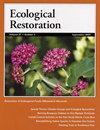道格拉斯·w·塔拉米的《橡树的本性》
IF 1.1
4区 环境科学与生态学
Q2 ECOLOGY
引用次数: 0
摘要
作为一名对橡子的利用和橡树管理有着长期兴趣的修复生态学家和环境历史学家,我以一种略带怀疑的眼光看待关于橡树的新书。道格拉斯·塔拉米(Douglas Tallamy)的新书《橡树的本性》(The Nature of Oaks)给了我们一个惊喜。这是一本任何人都参与恢复或管理与橡树的财产会发现的兴趣。即使你不与橡树打交道,橡树凋落叶、树枝和树叶以及树皮裂缝中的复杂生态系统也会为你可能正在处理和应该考虑的复杂相互关系提供新的见解。这本书跟随橡树年,一个月一个月,深入了解橡树上和橡树下发现的通常看不见的昆虫、蠕虫、线虫和真菌。它们的数量惊人,每平方米多达10万只弹尾。塔拉米还揭示了林下植被的重要性,这是我甚至没有想象到的。在橡树上发现的大多数毛虫会掉到地上,在落叶堆中化蛹或结茧。如果地面被修剪、裸露或压实,昆虫将无法存活。这将意味着许多依靠毛毛虫喂养雏鸟的鸟类的幼虫数量会减少。筑巢的鸟类可能需要数万只毛毛虫才能成功筑巢(Tallamy 2019)。优秀的彩色照片带来了橡树昆虫世界的生活。复杂的栎树凋落物生态系统有助于减少入侵的vimum Microstegium(日本高枝草)和几种入侵蠕虫的传播,这些蠕虫正在杀死本地蠕虫。例如,collebolas以致病性镰刀菌为食并减少其影响(Klironomos和Bainbridge, 1995年)。塔拉米讨论了橡树提供的许多环境效益,包括碳封存(在树根以及树干和树枝上)。这些可爱的树木可以锁住碳数百年或数千年。生长在橡树根上的菌根真菌也将碳作为球囊素封存(Hossain 2021)。橡树有助于保水和减少洪水。它们为无数种鸟类、动物和小到土螨大小的生物提供食物。他提供了一个简短的指南,介绍了北美91种橡树中的许多种,并为它们的消失感到惋惜。近三分之一的人被认为有风险。他的研究小组揭露了在景观美化中使用非本地物种和外来物种入侵所造成的问题。他和他的学生一起,将四种入侵的树篱和四种原生树篱进行了对比。入侵植物篱中仍有一些本地物种,但毛虫生物量下降了96%。塔拉米为您的地区选择最好的橡树品种提供了建议,并讨论了种植和照顾橡树的挑战和选择。塔拉米是特拉华大学昆虫学和野生动物生态学的教授。他最详细地介绍了他最熟悉的东部橡树,但他也讨论了一些西部橡树。唯一缺少的是在欧洲入侵之前,对数百个部落和数十万人来说,橡树和橡子的管理和重要性的故事(Bainbridge 1987, 2001)。本文章由计算机程序翻译,如有差异,请以英文原文为准。
The Nature of Oaks by Douglas W. Tallamy
As a restoration ecologist and environmental historian with a long-time interest in the use of acorns and management of oaks, I approach new books on oaks with a somewhat skeptical eye. Douglas Tallamy’s latest book “The Nature of Oaks” was a delightful surprise. This is a book anyone involved in restoration or management of a property with oaks will find of interest. Even if you don’t work with oaks, the complex ecosystems in oak leaf litter, on branches and leaves, and in cracks in bark will offer new insights into the complex interrelationships with which you might be dealing and should consider. The book follows the oak year, month by month, with insight into the often unseen insects, worms, nematodes, and fungi found in and under oak trees. These can be found in surprising numbers, up to 100,000 springtails (collembolas) per square meter. Tallamy also reveals how important the understory is, something I did not even imagine. Most of the caterpillars found on oaks fall to the ground to pupate or spin a cocoon in the litter. If the ground is mowed, bare or compacted, the insects will not survive. This will mean fewer caterpillars for the many birds that rely on them to feed their fledglings. Nesting birds may require tens of thousands of caterpillars for a successful nesting season (Tallamy 2019). Excellent color photographs bring the oak insect world to life. The complex oak litter ecosystem helps reduce the spread of invasive Microstegium vimineum (Japanese stiltgrass) and several invasive worms that are killing off the native worms. Collembolas, for example, graze on and reduce the impact of pathogenic Fusarium fungi (Klironomos and Bainbridge, 1995). Tallamy discusses the many environmental benefits oaks offer, including carbon sequestration (in tree roots as well as trunks and branches). These lovely trees can lock up carbon for hundreds or thousands of years. The mycorrhizal fungi growing on oak roots also sequester carbon as glomalin (Hossain 2021). Oaks aid in water retention and reduce flooding. They feed myriad species of birds, animals, and smaller creatures down to the size of soil mites. He offers a short guide to many of the 91 oak species in North America and bemoans their loss. Almost a third are considered at risk. His research group has exposed the problems caused by using non-native species in landscaping and the invasion of unwanted species. Working with his students, he matched four invaded to four native hedgerows. The invaded hedgerow still had some native species, but caterpillar biomass had dropped 96%. Tallamy gives advice on selecting the best oak species for your area and discusses the challenges and options for planting and caring for oaks. Tallamy is a professor in the Department of Entomology and Wildlife Ecology at the University of Delaware. His information is most detailed on the eastern oaks he knows best, but he does discuss some of the western oaks. The only thing missing is the story of the management and importance of oaks and acorns for hundreds of tribes and hundreds of thousands of people prior to the European invasion (Bainbridge 1987, 2001).
求助全文
通过发布文献求助,成功后即可免费获取论文全文。
去求助
来源期刊

Ecological Restoration
Environmental Science-Nature and Landscape Conservation
CiteScore
1.70
自引率
12.50%
发文量
24
期刊介绍:
Ecological Restoration is a forum for people advancing the science and practice of restoration ecology. It features the technical and biological aspects of restoring landscapes, as well as collaborations between restorationists and the design professions, land-use policy, the role of education, and more. This quarterly publication includes peer-reviewed science articles, perspectives and notes, book reviews, abstracts of restoration ecology progress published elsewhere, and announcements of scientific and professional meetings.
 求助内容:
求助内容: 应助结果提醒方式:
应助结果提醒方式:


